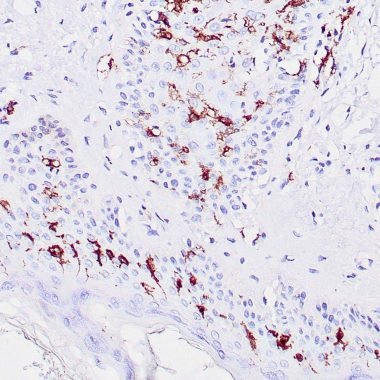
The CD1a Antibody (Mouse Monoclonal, Clone O10) is a highly specific, rigorously validated antibody designed for the reliable detection of CD1a, a transmembrane glycoprotein expressed on Langerhans cells, cortical thymocytes, and certain subsets of dendritic cells. As a member of the CD1 family involved in lipid antigen presentation to T cells, CD1a is an important marker in dermatopathology, immunology, and hematological malignancy diagnostics. Clone O10 is a well-established mouse monoclonal antibody that binds selectively to human CD1a, making it an essential tool for identifying Langerhans cells in normal skin, Langerhans cell histiocytosis (LCH), and cutaneous T-cell lymphomas (CTCL). This antibody delivers robust, high-contrast membranous staining in formalin-fixed paraffin-embedded (FFPE) tissues, and is compatible with additional applications such as flow cytometry and immunofluorescence (IF), allowing for multi-platform versatility. Extensively used in clinical pathology, Clone O10 aids in the diagnosis and classification of Langerhans cell neoplasms, and supports immune profiling in skin biopsies, thymic tissue, and various hematologic cancers. Its strong performance, low background, and precise targeting make it a trusted reagent for both research and diagnostic settings.
Mouse
Human thymus cells
O10
IgG1/ Kappa
CD1a is used to identify interdigitating dendritic cell sarcoma of the lymph node, extranodal histiocytic sarcoma, a subtype of T-lymphoblastic lymphoma/leukemia, and Langerhans cell histiocytosis (Histiocytosis X).
Human. Others not known.
MOLT-4 cells. Paracortex in a tonsil or a reactive lymph node.
Cell surface